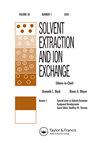工业加工中锂离子电池的回收利用:溶剂萃取法处理和回收高纯锰
IF 2.1
4区 化学
Q3 CHEMISTRY, MULTIDISCIPLINARY
引用次数: 5
摘要
锰在锂离子电池(LIBs)中起着核心作用,但与锂离子电池中存在的其他有价金属(如Co和Ni)相比,锰的回收利用很少得到解决。因此,本工作的主要目标是研究并实现在升级反应器中使用盐酸从lib获得的渗滤液中溶剂萃取Mn与Co和Ni的分离,这是本工作的一个创新方面。结果证实了D2EHPA对Mn具有较高的选择性,可通过两个阶段(0.5 M D2EHPA, pH为2.5)完全提取。共萃取金属主要为Al、Cu和Co,但浓度低于Mn。同时还对锌、镁等微量杂质的行为进行了监测。使用氯化锰进行洗涤对于去除负载有机物中的杂质并防止其出现在汽提产品中至关重要,高O:A比对洗涤效率产生负面影响。在汽提阶段将HCl浓度保持在0.5 M以内有助于限制杂质的汽提。氧化锰的析出产物纯度为99.5%(含微量Zn、Cu和Co),可在电池价值链中重复利用。本文章由计算机程序翻译,如有差异,请以英文原文为准。
Recycling of Li-Ion Batteries from Industrial Processing: Upscaled Hydrometallurgical Treatment and Recovery of High Purity Manganese by Solvent Extraction
ABSTRACT Manganese plays a central role in lithium-ion batteries (LIBs) but its recycling is rarely addressed when compared to other valuable metals present in LIBs, such as Co and Ni. Thus, the main goal of this work was to study and achieve the separation of Mn from Co and Ni by solvent extraction from a leachate obtained from LIBs using hydrochloric acid in an upscaled reactor, which is an innovative aspect of this work. The results confirmed the high selectivity of D2EHPA towards Mn, which could be completely extracted in two stages (0.5 M D2EHPA at pH 2.5). The main co-extracted metals were Al, Cu and Co, but with lower concentrations than Mn. The behavior of minor impurities such as Zn and Mg was also monitored. Scrubbing using manganese chloride was crucial to remove impurities from the loaded organic and prevent their presence in the stripping product, and high O:A ratios negatively affected the scrubbing efficiency. Keeping the concentration of HCl up to 0.5 M in the stripping stage helped to limit the stripping of impurities. Manganese oxide was precipitated as a product with 99.5% purity (with traces of Zn, Cu and Co), which could be reused in the battery value chain.
求助全文
通过发布文献求助,成功后即可免费获取论文全文。
去求助
来源期刊
CiteScore
4.40
自引率
5.00%
发文量
15
审稿时长
8.4 months
期刊介绍:
Solvent Extraction and Ion Exchange is an international journal that publishes original research papers, reviews, and notes that address all aspects of solvent extraction, ion exchange, and closely related methods involving, for example, liquid membranes, extraction chromatography, supercritical fluids, ionic liquids, microfluidics, and adsorption. We welcome submissions that look at: The underlying principles in solvent extraction and ion exchange; Solvent extraction and ion exchange process development; New materials or reagents, their syntheses and properties; Computational methods of molecular design and simulation; Advances in equipment, fluid dynamics, and engineering; Interfacial phenomena, kinetics, and coalescence; Spectroscopic and diffraction analysis of structure and dynamics; Host-guest chemistry, ion receptors, and molecular recognition.

 求助内容:
求助内容: 应助结果提醒方式:
应助结果提醒方式:


